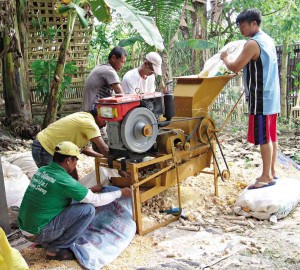Quezon gov’t pays farmers to be more productive

CORN farmers in Mulanay town in Quezon learn to operate a corn sheller machine. QUEZON AGRICULTURE OFFICE/CONTRIBUTOR
Corn farmer Arsenia Abarientos used to net only around P5,000 every harvest season from her field in Barangay (village) Matandang Sabang Silangan in the first-class municipality of Catanauan in Quezon province.
“I plant only what my little money can afford to sustain. I abhor loans. I have already escaped from the debt trap and I don’t want to return to it,” she said in a mobile phone interview.
Abarientos, a mother of six, saw her earnings leaped to P28,000—minus costs of labor and farm inputs—in October after joining the Farmers Productivity Enhancement Program (FPEP), which the provincial government started four months before.
She and some 150 other corn farmers from Catanauan, San Andres, San Francisco, Mulanay, Buenavista and San Narciso in Quezon’s Bondoc Peninsula were in the pioneer batch of the program, which was conceptualized by Gov. David Suarez.
“Our aim is to provide and assist the farmer with all he or she needs to make the farm more productive. From land preparation-planting-harvesting-marketing, including giving him advance payment for labor,” said Roberto Gajo, provincial agriculturist.
Article continues after this advertisementThe participants receive P5,000 every month in incentive allowance during the four months of corn production as payment for the care and management of their own farms. Much like regular state workers on government payroll, they receive the fees from a provincial cashier who travels from village to village at the end of each month.
Article continues after this advertisement“I think Quezon province is the only one with this kind of support program for the farmers,” Gajo said.
Aside from the stipend, the farmers are provided planting materials, pesticide, fertilizer and modern farming technology support, like soil testing, during the whole cropping season.
The FPEP, which initially covered 155 hectares, was supported by a P13-million fund. The crops are insured with the Philippine Crop Insurance Corp. (PCIC) against pest infestation and destructive weather, with the provincial government paying the premium.
Gajo explained that corn was chosen as one of the main products in the pilot area. The program would be replicated in other parts of the province to benefit other crop farmers.
Based on the feasibility study, the farmer is expected to harvest an average of five metric tons per hectare of corn farm after four months of modern farming without any serious weather intervention and pest infestation.
After the harvest, the provincial government will market the crops to feed mills to ensure a competitive price. From total harvest earnings, it will deduct the cost of farm inputs and total amount of monthly allowances—without interest—that the farmers received during the cropping season.
“The returned amount will serve as a revolving fund of the program for the next cropping season,” Gajo said.
Citing an age-old practice in the villages, Suarez noted how traders dictated the already low price of harvested products. “The poor farmers could not do anything to change the system because they are heavily indebted to the trader,” he said.
“We want to help the farmers escape from the bondage imposed by the traders and product buyers through usurious loans and farm inputs with prohibitive price tags,” Suarez said.
He said the FPEP was a gamble on the provincial government’s part as its intention was not to make a profit. “Our main purpose is to help the farmers, empower and make them more productive for their families and communities,” he said.
“God is really kind,” said Abarientos, who tills less than a hectare of farm lot that the family owns. She also gifted herself with a cheap cell phone from her earnings.
While a small area of her farm was attacked by pests, the woman said she was expecting insurance payment for the crop loss.
Poor farmers
The program is a “big help to marginalized farmers” like her, she said. Usually, after planting, she had to look for another work, most often as house help in the town proper, to help her husband, a jeepney driver, in supporting the family.
“Now, with the monthly advance payment from the government, my attention is focused only on my family and on how to make my corn farm more productive,” Abarientos said.
All FPEP beneficiaries completed the four-month farmers’ field school in corn production that involved on-field actual training. Gajo expected them to be ready to stand on their own and continue modern farming with minimum government support after five cropping seasons.
The official said the provincial government was doing away with the common practice of national government agencies that provide only occasional assistance to the farmers. After the agencies had distributed the seeds and farm implements, the recipients were often left on their own without access to funds for other inputs, he said.
“They become vulnerable to exploitative practices of usurious traders and buyers. We want to erase that phase,” Gajo said.